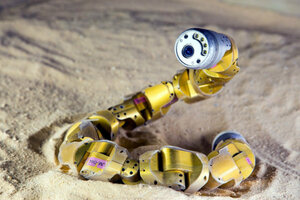Robot snake slithers like a sidewinder, the 'ultimate all-terrain vehicle'
Scientists designed the first robot snake to scoot across land, swim, dig, climb, or glide. It's a skill set that will allow robot snakes to carry out search-and-rescue operations that would stump a wheeled robot.

A sidewinder rattlesnake robot is pictured in this undated handout photo provided by Chaohui Gong. Researchers on Thursday said they conducted experiments to learn precisely how sidewinder rattlesnakes are able to climb sandy hills, then applied the reptiles' repertoire to an existing snake robot, so it could do the same thing.
Chaohui Gong/Handout/Reuters
Researchers have coaxed a robotic snake to slither like a sidewinder in hopes of developing truly all-terrain robots that could help hunt for people in collapsed buildings, inspect the innards of nuclear power plants, or act as survey tools at potential archaeology sites.
At the same time, the robot, dubbed Elizabeth, has helped test ideas about how sidewinders wriggle across the landscape, negotiating sandy terrain, especially sandy terrain involving slopes, that would confound down lesser creatures, let alone robots.
Over the years, researchers have been using robots – from robotic lobsters to robotic insects – to understand how such creatures move or sense their surroundings. And they have recognized the usefulness of trying to mimic those natural characteristics in robots.
For their part, snakes represent the ultimate all-terrain vehicle, according to a team of physicists and engineers reporting the results of their robotic sidewinder project in today's issue of the journal Science.
Snakes can scoot across land, swim, dig, climb rough surfaces, and, in some cases, glide. But why focus on sidewinders?
"The desert sidewinder is really extraordinary, with perhaps the fastest and most efficient natural motion we've ever observed for a snake," said Ross Hatton, an assistant professor of mechanical engineering at Oregon State University in Corvallis and a member of the research team, in a prepared statement.
The team's work had a distinct, don't-try-this-at-home feel to it.
Team members – including Hamidreza Marvi, a Georgia Tech researcher who was the lead author of the paper appearing in Science – made a quick trip to Arizona, captured six adult sidewinders, packed up 440 pounds of their favorite Arizona sand, and brought them to the Atlanta Zoo. There, physicists from Georgia Tech used high-speed video to record the sidewinders' movements on flat and inclined sandy surfaces and compared the sidewinders' action with that of members of 13 species of pit vipers the zoo had on hand.
Many of these pit vipers, which don't use side-winding motions, couldn't move across a flat sandy surface if their scaly lives depended on it. And all but one failed to move uphill.
As the team analyzed the videos, it became clear that the sidewinders were moving their body segments in wave-like motions vertically as well as horizontally, based on the condition of the surface they were traversing. On harder surfaces, these combined motions reduced the area of their body that came into contact with the surface. On loose granular surfaces, the snakes increased this contact area.
The researchers programmed the physics behind what they saw into Elizabeth, the robotic snake provided by Howie Choset, a robotics professor at Carnegie Mellon University in Pittsburgh. Betsy is about twice as long as the snakes it was mimicking and consists of segments whose joints are designed to reproduce some snake-like movements.
Prior this project, Dr. Choset had given his snake a trial run at an archaeology site in Egypt. Using part of the movement sidewinders use, the robosnake could move across a flat surface, but not up sandy slopes. The same held true on the sandy inclines the team used to record the sidewinders' movements.
Programmed to mimic the vertical as well as the horizontal movements seen in the sidewinders, Elizabeth the robosnake was able to slither up slopes that it couldn't negotiate before.
This ability and the process that led to it "has brought us one step closer to achieving life-like locomotion in robots," writes John Socha, who specializes in biomedical engineering at Virginia Tech in Blacksburg, Va., in an analysis in Science that accompanies the paper, detailing the team's results.

